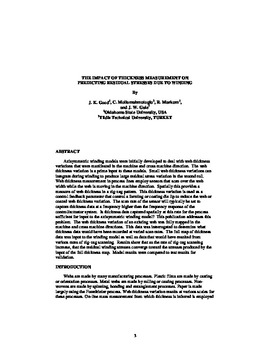| dc.contributor.author | Good, J. K. | |
| dc.contributor.author | Mollamahmutoglu, C. | |
| dc.contributor.author | Markum, R. | |
| dc.contributor.author | Gale, J. W. | |
| dc.contributor.other | International Conference on Web Handling (2015) | |
| dc.date.accessioned | 2019-11-12T17:30:14Z | |
| dc.date.available | 2019-11-12T17:30:14Z | |
| dc.date.issued | 2015-06 | |
| dc.identifier | oksd_icwh_2015_good | |
| dc.identifier.citation | Good, J. K., Mollamahmutoglu, C., Markum, R., & Gale, J. W. (2015, June). The impact of thickness measurement on predicting residual stresses due to winding. Paper presented at the Thirteenth International Conference on Web Handling (IWEB), Stillwater, OK. | |
| dc.identifier.uri | https://hdl.handle.net/11244/322050 | |
| dc.description.abstract | Axisymmetric winding models were initially developed to deal with web thickness variations that were manifested in the machine and cross machine direction. The web thickness variation is a prime input to these models. Small web thickness variations can integrate during winding to produce large residual stress variation in the wound roll. Web thickness measurement in process lines employ sensors that scan over the web width while the web is moving in the machine direction. Spatially this provides a measure of web thickness in a zig-zag pattern. This thickness variation is used as a control feedback parameter that control a forming or coating die lip to reduce the web or coated web thickness variation. The scan rate of the sensor will typically be set to capture thickness data at a frequency higher than the frequency response of the control/actuator system. Is thickness data captured spatially at this rate for the process sufficient for input to the axisymmetric winding model? This publication addresses this problem. The web thickness variation of an existing web was fully mapped in the machine and cross machine directions. This data was interrogated to determine what thickness data would have been recorded at varied scan rates. The full map of thickness data was input to the winding model as well as data that would have resulted from various rates of zig-zag scanning. Results show that as the rate of zig-zag scanning increase, that the residual winding stresses converge toward the stresses produced by the input of the full thickness map. Model results were compared to test results for validation. | |
| dc.format | application/pdf | |
| dc.language | en_US | |
| dc.publisher | Oklahoma State University | |
| dc.rights | In the Oklahoma State University Library's institutional repository this paper is made available through the open access principles and the terms of agreement/consent between the author(s) and the publisher. The permission policy on the use, reproduction or distribution of the article falls under fair use for educational, scholarship, and research purposes. Contact Digital Resources and Discovery Services at lib-dls@okstate.edu or 405-744-9161 for further information. | |
| dc.title | Impact of thickness measurement on predicting residual stresses due to winding | |
| osu.filename | oksd_icwh_2015_good.pdf | |
| dc.description.department | Mechanical and Aerospace Engineering | |
| dc.type.genre | Conference proceedings | |
| dc.type.material | Text | |
